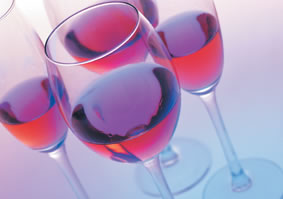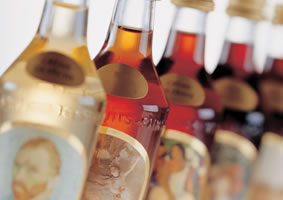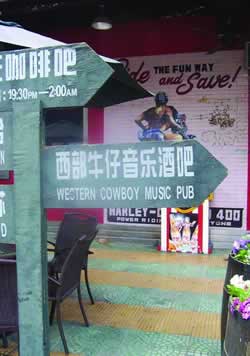| New trends in going out on the town in China中国古城中心的流行时尚 |
| http://www.sina.com.cn 2003/12/10 14:08 中国周刊 |
◆By Mark Godfrey
An alcoholic revolution in China has seen the world most populous land become the world most sought after drinks market. China is set to overtake the US as the largest producer and consumer of beer in the coming few years. Its wine industry, meanwhile, is expected to take off for similarly stratospheric levels. Beer drinking is not traditional to China: it was the West that brought beer to the Middle Kingdom over a hundred years ago. A German brewing company opened China first brewery in the coastal city of Qingdao in 1903. Ironically, while China consumption of beer is racing ahead, drinkers in traditional beer nations like Germany are slowly shifting from beer to other alcoholic beverages and fruit juices. Still, Germany is home to 1,400 breweries, more than any other European nation. The emtlichkeit?is good over at the Paulaner Brauhaus, in Beijing Chaoyang district. Prices are a cheeky 50 Yuan for the in-house brew but there plenty of custom for this premium brew at the huge and rather kitschy recreation of a Bavarian beerhall. The prices are at least double those charged for the same product in Paulaner hometown of Munich, capital of southern Germany. It a similar story at some of Beijing other bars. Durty Nelly, Beijing best known Irish pub, sells Ireland renowned Guinness stout at 50 Yuan a pint glass. A similar measure costs the equivalent of 35 Yuan in O誅onoghue Pub on Merrion Row in Dublin government and business district. The phenomenon of expensive foreign drinking tastes is not confined to China capital. On a recent trip to Fuzhou, capital of East China Fujian Province, this writer discovered a strip of designer-made theme bars, ranging from a Scottish-tinged pub with live music to a giant Country Western style emporium attempting to take Texas a little nearer to Fujian province. The common theme on the kit-box new strip however was the beer menu. Fuzhou brews a fine local beer, Huiquan, but local beers weren an option on the trendy night strip: Heineken, Budweiser and San Miguel were not only the big sellers but the only beers on sale. The prices meanwhile easily matched, if not outdid, European bar prices. At 35 Yuan, a half-cooled bottle of Heineken is not a cheap drink in China hinterland. And yet, all of these beers are today produced locally in China, leaving little excuse for high prices other than bar owners?greed.
Teacher and Shandong native Charles Yang could be classified as a typical Chinese drinker. He drinks Beijing favourite Yanjing ne a day during summer?and ne or two a week?during the rest of the year, epending on my work schedule.?Yang rarely drinks wine. hen I was at university I did. Chinese wine is too strong. I like to try brandy though.? China has cultivated vines and produced wine for over 4,000 years, but Chinese viniculture differs from that of the West, particularly in the production methods. Chinese vineyards are more intensively farmed than those in Europe or the Americas, and tastes of local and Western consumers differ. Chinese diners like to take wine for health purposes, hence the infusion of herbs in many local varieties which rarely meet with favour among expat drinkers. In its promotional material, China leading wine maker Great Wall casts itself as a Chinese equivalent to Bordeaux celebrated reds. he world is blessed with two suns. One shines anywhere and one shines on us.?Evoking the munificence of God constantly, the brand claims to originate from olden harvest lands... created through the test of time and stored using unique methods. A premium wine unbound by distance, only the best of flavour blessed by God.?Great Wall has much to live up to then. Whatever its PR guff, the brand is certainly a national success story. An infusion of Western expertise has helped sharpen the label production techniques as well as its image. Global wine production sits at 27 millions tonnes a year. Of that figure, China produces 300,000 tonnes per annum. Annual per capita wine consumption across the world meanwhile averages at 7.5 litres, while Chinese drinkers?intake reaches only half a litre. The growth in consumption figures worldwide tells a different story however. World consumption of wine increased by 6.5 percent between 1994 and 2000 but the increase in China consumption of wine over the period came to an incredible 68 percent. Expats living in China have brought foreign tastes to China cities and helped spur the frenzied building of bars in Beijing and Shanghai in particular. Locals whoe joined the trend - and who can afford to drink there - are essential to the viability of bars and nightclubs, however. Drink menus have gestated to a mixture of local and foreign labels and prices. According to US public relations executive Tzyy Wang, don have a favourite drink here in Beijing. It depends on the bar. But I have been known to coddle my Jack Daniels and cokes and Long Island Ice Teas.? used to have about 15 units of alcohol in any given week...now it like five at the most. Il drink pretty much everywhere. But specifically I like Beijing bars like the Hidden Tree, Nashville, Tanewha, Rainbow, Jazz Ya and Huxley in the Sanlitun area. In the Chaoyang Park area I frequent Black Sun 2, Latinos and Suzy Wongs. Whatever isn too noisy at Houhai. Plus, house parties rule! Theye a favourite drinking place for me.?Teacher and researcher Linda Choi meanwhile sticks to non-alcoholic drinks. y preference is for good Chinese tea at teahouses or at friends?places. I drink about once every two weeks.?She also tried some of the local wines. hite is usually too dry. The more expensive or higher quality local brands of red wine, such as Dragon Seal, are normal and often taste like Western restaurant house wines. There is not much variety in the local Chinese wine brands. I mean there not much in the way of anything apart from Cabernet. Restaurants will usually have good Shiraz or Cabernet styles. I am no wine expert, though. I drink it maybe once a month when dining out in Western restaurants. I don drink beer.?Others have avoided Chinese wines and stuck with familiar global drinks brands. y favourite drink is Corona, a Mexican beer - nothing related to China?says Danielle Andre, from Mauritius. drink twice a week, in pubs. Chinese beer is quite good but Chinese wine gives headaches so I drink it rarely!?adds the Beijing-based English teacher. A regular drinker of various Chinese beverages, Tzyy Wang takes a more positive view of the local viniculture. f youe talking the grape kind, then some are surprisingly good. The white wines, such as Fengshou, are generally not bad but the reds are a bit harder to pick out. You have your staple goodies like Dragon Seal and Great Wall, but the one from Xinjiang is especially good and reasonably priced. Imported wine still remains the choice for wine lovers, though. I go through a bottle or two of that each month.?hinese wine typically comes from the grain rather than the grape and certain fruits, such as plums and berries. Those tend to be quite sweet (very much like a wine cooler). The taste of grain alcohol is rather strong in China - it has to be an acquired taste. This stuff can literally clean the grease off your bicycle chain! I would reserve this for the banquets and weddings were it is served freely and the kick comes surreptitiously. I go through a bottle like once every 2 years - one of the very, very, small flasks!?
Judging by supermarket shelves, China wine industry has plenty of potential. Provincial retailers rarely stock foreign labels but that set to change in 2004 when the 65 per cent tariff currently faced by foreign producers is reduced to a much more competitive 14 per cent. The three giants of Chinese wine are Great Wall, Changyu and Dynasty. These three dominate the market and produce the best quality products. All of the leaders have their base in eastern China but the focus of China wine industry appears to be shifting westwards. According to a report on China wine consumption by European consultancy firm Friedl, wine drinking has become a mark of sophistication among Chinese people. ine tends to be drunk in Western-style restaurants... to show good taste... and sophistication?according to the study, released earlier this year. Chinese women tend to drink white wine but the market for both red and white wine has doubled in the past five years, according to the Friedl report. Sophistication seems to be a driving motivation for both Chinese beer and wine drinkers. Foreign beer makers, faced with low margins on their Chinese investments, have been attempting to market their upscale products as esigner?beers to fashion-conscious Chinese drinkers. The future of China drinks industry remains unclear. If the country is to follow the way of the West, a small number of huge brewing companies will control the market, most of them likely part or fully owned by foreign parent companies. China alcohol consumption remains well below that of the world average. The myriad problems of excessive drinking and teenage alcohol abuse have hardly been hinted at by researchers or product promoters, but they pose possibly calamitous problems for China society, as these trends have in Western countriesswheresdrinks companies actively target young drinkers. For now, Western brewing giants and sommeliers will muse and puzzle over how to make profit on the most promising market in the world for their products. As the global giants come to China, so China beermakers are also movingsintosforeign markets. Tsingtao and Yanjing have both enteredsintosexport agreements with import and distribution companies in Europe and the US. Yanjing meanwhile, seeking to become a trendy choice beer among Americans, has signed a sponsorship deal with the Houston Rockets basketball team, home of Chinese and NBA star Yao Ming. According to the State Bureau of Quality & Technical Supervision the quality of Chinese beers has onsistently improved.?Some, however, are spoiled by oo many enzymes.?Price, not enzymes remains the largest obstacle for many drinkers crowding onto Beijing late-night bar scene. Linda Horka, from the Czech Republic, a land synonymous with good beer, believes the bars in China capital are ?.. a bit pricy.?A Tsingtao drinker, Horka frequents the Sanlitun and Houhai bar zones most weekends and drinks with friends regularly during the week. he local beers are pretty good, and I always drink that when I out. The wine is too expensive to become a regular habit. Back home you can buy a good Czech wine much more cheaply. |
| 【英语学习论坛】【评论】【大 中 小】【打印】【关闭】 |
 It four on a Friday morning. There are jobs to go to, but Beijing bars are still selling. And they will do so for some time yet. Bars with global-Asian names like the Den, the Hidden Tree, the No Name Bar and Suzy Wong don let the late hour get in the way of serving thei brews. Bountiful growth of its bar and club trade has been making Beijing and Shanghai good-time cities to rival Western metropolises. Rapid expansion of the bar scene in the Sanlitun and Houhai zones has given Beijing a playgroundswheresChina nouveaux riches join expats and visiting tourists and businesspeople to drink and make merry.
It four on a Friday morning. There are jobs to go to, but Beijing bars are still selling. And they will do so for some time yet. Bars with global-Asian names like the Den, the Hidden Tree, the No Name Bar and Suzy Wong don let the late hour get in the way of serving thei brews. Bountiful growth of its bar and club trade has been making Beijing and Shanghai good-time cities to rival Western metropolises. Rapid expansion of the bar scene in the Sanlitun and Houhai zones has given Beijing a playgroundswheresChina nouveaux riches join expats and visiting tourists and businesspeople to drink and make merry.  At a flashy new bar-club in Changsha, capital of Central China Hunan province, the prices were even steeper when I called in last month. Here the two American beer giants, Budweiser and Coors, were competing for punters?wallets, uniformed sales girls clamouring for custom at the entrances to the bar. Few customers got near the bar counter,swheresrepresentatives of spirits makers like Jack Daniels and Bacardi were vying just as enthusiastically for the trade. But at prices ranging from 40 yuan for a beer to 60 yuan for a cocktail, and a minimum spend requirement in force, one could only leave this joint with the feeling ofshavingsbeen cheated.
At a flashy new bar-club in Changsha, capital of Central China Hunan province, the prices were even steeper when I called in last month. Here the two American beer giants, Budweiser and Coors, were competing for punters?wallets, uniformed sales girls clamouring for custom at the entrances to the bar. Few customers got near the bar counter,swheresrepresentatives of spirits makers like Jack Daniels and Bacardi were vying just as enthusiastically for the trade. But at prices ranging from 40 yuan for a beer to 60 yuan for a cocktail, and a minimum spend requirement in force, one could only leave this joint with the feeling ofshavingsbeen cheated.  French hotel executive Christelle de Giafferi has stuck to her long-term favourite drink since moving to Beijing earlier this year. y favourite drink when I in China is Absolut vodka. I drink around once a week, at pubs and clubs. Chinese wine is quite good, but I don drink it really often. And I do not like beer, so I don know much about the beers here.?More knowledgeable about local brews, the taste and texture of Chinese brews, Tzyy Wang from Ohio sometimes however has problems with quality consistency among local brews. hinese beer tends to be more on the light, pilsner side. There isn much variety in taste - beer is sometimes cheaper than water, so in many cases, it should taste like water. Yangjing and Beijing beer are the local brews and are more widely available in Beijing. Quite a few local breweries exist but most use foreign brewing technologies. There are certain varieties of fruit beer. Pineapple beer can be purchased at the local Jingkelong supermarket but it not as refreshing. And I don think Ie ever seen an ale.?誨probably have a beer almost every meal time, if I had a choice. Beer connoisseurs would have a hard time trying different types of Chinese beer, and there are few micro brewed beers in China. There are some restaurants in Beijing that do serve micro brewed beer but those are few and far in between.?With up to 500 breweries in operation across the country, China brewing business is worth approximately US billion. According to economist Marc Greenberg of Deutsche Bank ost of it is very low margin, unattractive business.?There has been some consolidation however. Tsingtao and Yanjing have both been buying up regional brewers, the former taking a stake recently in a major brewing operation in Changsha, Hunan province, while Yanjing has boughtsintosHuiquan, the leading brewer in Fujian.
French hotel executive Christelle de Giafferi has stuck to her long-term favourite drink since moving to Beijing earlier this year. y favourite drink when I in China is Absolut vodka. I drink around once a week, at pubs and clubs. Chinese wine is quite good, but I don drink it really often. And I do not like beer, so I don know much about the beers here.?More knowledgeable about local brews, the taste and texture of Chinese brews, Tzyy Wang from Ohio sometimes however has problems with quality consistency among local brews. hinese beer tends to be more on the light, pilsner side. There isn much variety in taste - beer is sometimes cheaper than water, so in many cases, it should taste like water. Yangjing and Beijing beer are the local brews and are more widely available in Beijing. Quite a few local breweries exist but most use foreign brewing technologies. There are certain varieties of fruit beer. Pineapple beer can be purchased at the local Jingkelong supermarket but it not as refreshing. And I don think Ie ever seen an ale.?誨probably have a beer almost every meal time, if I had a choice. Beer connoisseurs would have a hard time trying different types of Chinese beer, and there are few micro brewed beers in China. There are some restaurants in Beijing that do serve micro brewed beer but those are few and far in between.?With up to 500 breweries in operation across the country, China brewing business is worth approximately US billion. According to economist Marc Greenberg of Deutsche Bank ost of it is very low margin, unattractive business.?There has been some consolidation however. Tsingtao and Yanjing have both been buying up regional brewers, the former taking a stake recently in a major brewing operation in Changsha, Hunan province, while Yanjing has boughtsintosHuiquan, the leading brewer in Fujian.